Archive:Employment activities statistics - NACE Rev. 2
This Statistics Explained article is outdated and has been archived - for recent articles on structural business statistics see here.
- Data from October 2015. Most recent data: Further Eurostat information, Main tables and Database.
This article presents an overview of statistics for the employment activities sector in the European Union (EU), as covered by NACE Rev. 2 Division 78. It belongs to a set of statistical articles on 'Business economy by sector'
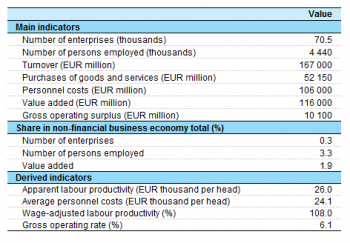

(% share of sectoral total) - Source: Eurostat (sbs_na_1a_se_r2)



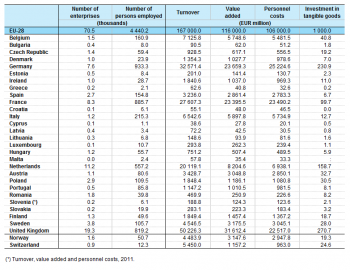
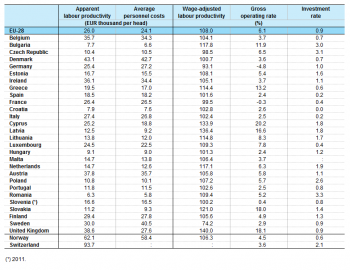


(% share of sectoral total) - Source: Eurostat (sbs_sc_1b_se_r2)
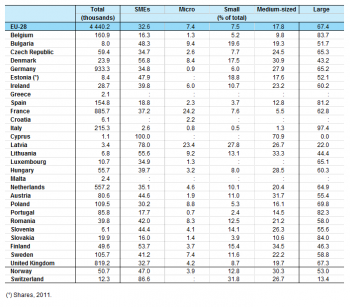
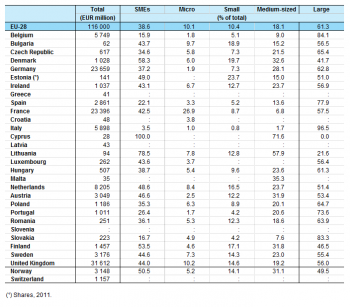
Main statistical findings
Structural profile
There were 70.5 thousand enterprises operating within the employment activities sector (Division 78) in the EU-28 in 2012. Together they employed 4.4 million persons, equivalent to 3.3 % of the non-financial business economy (Sections B to J and L to N and Division 95) workforce and one third (33.2 %) of the total number of persons employed in administrative and support services (Section N). These enterprises engaged in the EU-28’s employment activities sector generated EUR 116.0 billion of value added in 2012 which was 1.9 % of the non-financial business economy total or in excess of one quarter (27.4 %) of the administrative and support services total.
It is important to note that many persons employed by employment agencies work either atypical hours, on a part-time basis, or on temporary contracts. For some people this flexibility offers them the possibility to balance work and personal obligations, while for others their recourse to working for an employment agency may be borne out of the necessity to find work, and in this case their employment may be described as being precarious in nature. The statistics presented in this article relate to head counts of persons employed, and as such it is likely that the information presented overstates the volume of labour input, as not all of the persons who are employed by employment agencies are working on a regular, full-time basis. Equally, per head productivity measures such as apparent labour productivity are influenced by the incidence of part-time or temporary work and the low levels of productivity typically observed within this sector should be viewed in this context.
The apparent labour productivity ratio of the EU-28’s employment activities sector stood at EUR 26.0 thousand of added value per person employed in 2012, well below the non-financial business economy average of EUR 46.2 thousand per person employed and some EUR 6.0 thousand per person employed lower than the average for administrative and support services as a whole.
The very low level of apparent labour productivity for the EU-28’s employment activities sector — the sixth lowest among any of the NACE divisions that constitute the non-financial business economy — was mirrored in lower than average personnel costs per employee; this is also a ratio calculated on a per head basis and is therefore pulled downwards by higher levels of part-time and temporary work. In 2012, average personnel costs in the employment activities sector stood at EUR 24.1 thousand per employee compared with an average of EUR 32.4 thousand per employee for the non-financial business economy as a whole. By contrast, average personnel costs were higher for the EU-28’s employment activities sector than for administrative and support services as a whole (EUR 23.1 thousand per employee).
The wage-adjusted labour productivity ratio combines the two previous indicators and shows the extent to which the value added generated by each employed person covers the average personnel costs of each employee. As this indicator combines two ratios that are calculated on a per head basis the impact of part-time and temporary work is eliminated to a large extent, and so the wage-adjusted labour productivity ratio provides a more comparable basis for analysing productivity in this and other sectors. Very low apparent labour productivity and average personnel costs that were proportionally somewhat closer to the non-financial business economy average, resulted in a wage-adjusted labour productivity ratio for the EU-28’s employment activities in 2012 of 108.0 %. This was the joint fourth lowest ratio (along with the activities of head offices and management consultancy activities sector - Division 70) among the NACE divisions that constitute the non-financial business economy and was considerably below either the non-financial business economy average (142.7 %) or the administrative or support services average (137.0 %).
The gross operating rate (the relation between the gross operating surplus and turnover) is a measure of operating profitability; it stood at 6.1 % for the EU-28’s employment activities sector in 2012, which was 3.3 percentage points below the non-financial business economy average (9.4 %) and less than half the average rate recorded for administrative and support services (15.4 %).
Sectoral analysis
Of the three NACE groups that form the EU-28’s employment activities sector, temporary employment agency activities (Group 78.2) was the largest, using any measure of size. This subsector accounted for less than half (45.3 %) of all the enterprises in the EU-28’s employment activities sector in 2012. However, its share of sectoral value added (82.1 %) and employment (83.9 %) was considerably more pronounced. The next largest subsector concerned the activities of employment placement agencies (Group 78.1), which accounted for just over 4 out of every 10 (40.6 %) enterprises in 2012, but for much lower shares of sectoral value added (8.9 %) and sectoral employment (8.1 %). The smallest activity was that of other human resources provision (Group 78.3) which accounted for less than one seventh of enterprises in the employment activities sector (14.1 %), however, its shares on added value and sectoral workforce were similar to those of the activities of employment placement agencies sector (8.8 % and 8.1 % respectively).
The highest apparent labour productivity figure among the three subsectors that constitute the EU-28’s employment activities sector was recorded for employment placement agencies, at EUR 29.0 thousand of added value per person employed in 2012. This was EUR 3.0 thousand per person employed higher than for temporary employment agency activities in 2012 and EUR 2.0 thousand more than the productivity level recorded for other human resources provision (in 2011).
EU-28 average personnel costs peaked at EUR 26.5 thousand per employee for other human resources provision in 2012, while the remaining two subsectors reported levels that were somewhat lower and very similar, averaging EUR 24.0 thousand per employee for the temporary employment agency activities subsector and EUR 23.7 thousand per employee for the activities of employment placement agencies subsector. All of these values were well below the non-financial business economy average of EUR 32.4 thousand per employee.
The wage-adjusted labour productivity ratios of the subsectors that constitute the employment activities sector were all below the non-financial business economy average (142.7 %) and the administrative and support service activities average (137.0 %). The highest ratio (122.0 %) was recorded for the employment placement agencies subsector, while wage-adjusted labour productivity ratios for other human resources provision (108.0 %) and temporary employment agency activities (107.0 %) were much lower.
There was a wider range in values between the three subsectors for the gross operating rate, which is one measure of profitability. Within the EU-28, this rate peaked in 2012 at 11.4 % for activities of employment placement agencies, which was above the average for the whole of the non-financial business economy (9.4 %), but below the average for administrative and support service activities (15.4 %). The gross operating profitability of the other two subsectors was well below the non-financial business economy average in 2012, falling to 5.3 % for temporary employment agency activities and to 5.8 % for other human resources provision.
Country analysis
More than one quarter (27.3 %) of the EU-28’s value added within the employment activities sector in 2012 was generated in the United Kingdom, while Germany (20.4 %) and France (20.2 %) also accounted for high shares; the combined contribution made by these three countries was over two thirds (67.8 %) of the EU-28’s total added value. The same three EU Member States also employed the highest number of persons. The largest workforce within the EU-28’s employment activities sector in 2012 was registered in Germany (933.3 thousand persons), ahead of France (885.7 thousand) and the United Kingdom (819.2 thousand), while the Netherlands also had a large workforce (557.2 thousand) that was more than 2.5 times the size of the employment activities workforce in Italy or Spain. This is perhaps symptomatic of the relatively low level of recourse made to employment activities in southern Europe, whereas employment activities are more developed in the north west of Europe, particularly in the Netherlands.
The 5.0 % share of EU-28 value added recorded in this sector for Belgium was the sixth highest share for Belgium in any of the non-financial business economy NACE divisions (with data available) in 2012. As a consequence, in value added terms, Belgium was the second most specialised EU Member State in the employment activities sector in 2012, as some 3.0 % of its non-financial business economy value added was generated by this sector. The most specialised EU Member State was the United Kingdom (3.0 %), while the Netherlands and France (both 2.6 %) were also relatively specialised. Employment activities generated less than 1.0 % of non-financial business economy added value in Italy, Denmark, Spain and Greece, as well as in each of the Member States that joined the EU in 2004 or later, except for Hungary (1.1 %), Estonia (1.5 %) and Slovenia (the latter is not available). The non-member countries presented in Table 4a also reported a relatively low degree of specialisation for the employment activities sector. This sector accounted for just 0.4 % of non-financial business economy value added in Switzerland, while a somewhat higher share was recorded in Norway (1.4 %), although this latter figure remained 0.5 percentage points lower than the EU-28 average.
Across all of the EU Member States, wage-adjusted labour productivity ratios for employment activities were consistently lower than national non-financial business economy averages, the only exception was Greece. There were four countries, France, the Czech Republic, Germany and Sweden, where the wage-adjusted labour productivity ratio fell below 100 % — indicating that, on average, the value added generated by each person employed did not cover personnel costs per employee. The highest wage-adjusted labour productivity ratios were recorded in the United Kingdom and Latvia (140.0 % and 136.4 %), with ratios for the employment activities sector that were nevertheless around 25 % lower than their respective non-financial business economy averages.
Size class analysis
As was the case for administrative and support services activities as a whole, large enterprises (employing 250 or more persons) accounted for the majority of the value added and employment within the EU-28’s employment activities sector. There were 1.9 thousand large enterprises operating within the employment activities sector in 2012 and together they employed 3.0 million persons (or 67.4 % of the sectoral workforce), while generating EUR 71.1 billion of value added (61.3 % of the sectoral total).
Large enterprises accounted for more than half of the workforce in the majority of the EU Member States for which data are available. This pattern was broken in the north and north-east of the EU, where a small cluster of countries — Denmark, Latvia, Lithuania and Finland — reported that large enterprises contributed less than 50 % of their respective workforces; this was also the case in Cyprus. Indeed, Cyprus and Latvia were the only Member States where large enterprises failed to record the highest share of the employment activities workforce in 2012. Large enterprises also failed to record the highest share of the workforce in Switzerland, as the 1.7 thousand persons employed in large enterprises within the Swiss employment activities workforce represented just 13.4 % of the sectoral total. The share of large enterprises in the employment activities workforce in Switzerland was 54.1 percentage points lower than the EU-28 average, which marked the biggest difference across any of the NACE divisions that compose the non-financial business economy (subject to data availability).
The relative importance of large enterprises was particularly pronounced, in employment terms, in Italy, Slovakia, Belgium, Portugal and Spain, as large enterprises accounted for more than four out of every five persons in the employment activities workforce in 2012. This was quite surprising and in direct contrast to the general patterns observed for these four countries, where small and medium-sized enterprises (SMEs, employing fewer than 250 persons) provided a higher than average share of the non-financial business economy workforce.
The relationship between the average size of enterprises and their apparent labour productivity showed that within the employment activities sector there were diminishing returns to scale; the highest productivity ratios were recorded for small enterprises (EUR 36.3 thousand of value added per person employed) and micro enterprises (EUR 35.9 thousand per person employed). This figure fell progressively as a function of the average size of enterprises, to a low of EUR 23.7 thousand per person employed for large enterprises.
Data sources and availability
The analysis presented in this article is based on the main dataset for structural business statistics (SBS) and size class data, all of which are published annually.
The main series provides information for each EU Member State as well as a number of non-member countries at a detailed level according to the activity classification NACE. Data are available for a wide range of variables.
In structural business statistics, size classes are generally defined by the number of persons employed. A limited set of the standard structural business statistics variables (for example, the number of enterprises, turnover, persons employed and value added) are analysed by size class, mostly down to the three-digit (group) level of NACE. The main size classes used in this article for presenting the results are:
- small and medium-sized enterprises (SMEs): with 1 to 249 persons employed, further divided into;
- micro enterprises: with less than 10 persons employed;
- small enterprises: with 10 to 49 persons employed;
- medium-sized enterprises: with 50 to 249 persons employed;
- large enterprises: with 250 or more persons employed.
Context
This article presents an overview of statistics for the employment activities sector in the EU, as covered by NACE Rev. 2 Division 78. The activities of employment placement agencies include personnel search, selection referral and placement activities (including executive placement and search activities), as well as activities of casting agencies and bureaus. Temporary employment agency activities include activities of supplying workers to clients’ businesses for limited periods of time to supplement or temporarily replace the workforce of the client, where the individuals provided are employees of the temporary help service unit. However, units classified here do not provide direct supervision of their employees at the clients’ work sites. Other human resources provision includes the activities of providing human resources and human resource management services for client businesses. Providers of these services represent the employer of record for the employees on matters relating to payroll, taxes, and other fiscal and human resource issues, but they are not responsible for the direction or supervision of employees.
This NACE division is composed of three groups:
- activities of employment placement agencies (Group 78.1);
- temporary employment agency activities (Group 78.2);
- other human resources provision (Group 78.3).
Activities of agents for individual artists are excluded from the statistics covered in this article (see Division 74, part of other professional, scientific and technical activities).
See also
- Administrative and support service activities
- Other analyses of the business economy by NACE Rev. 2 sector
- Structural business statistics introduced
Further Eurostat information
Publications
- European business - facts and figures (online publication)
Main tables
Database
- SBS – services (sbs_serv)
- Annual detailed enterprise statistics - services (sbs_na_serv)
- Annual detailed enterprise statistics for services (NACE Rev. 2 H-N and S95) (sbs_na_1a_se_r2)
- SMEs - Annual enterprise statistics by size class - services (sbs_sc_sc)
- Services by employment size class (NACE Rev. 2 H-N and S95) (sbs_sc_1b_se_r2)
- Annual detailed enterprise statistics - services (sbs_na_serv)
- SBS - regional data - all activities (sbs_r)
- SBS data by NUTS 2 regions and NACE Rev. 2 (from 2008 onwards) (sbs_r_nuts06_r2)
Dedicated section
Source data for tables and figures (MS Excel)
Other information
- Decision 1578/2007/EC of 11 December 2007 on the Community Statistical Programme 2008 to 2012
- Regulation (EC) No 295/2008 of 11 March 2008 concerning structural business statistics